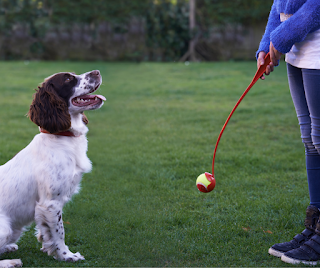The 3 Easy Steps Of Positive Dog Training
The 3 Easy Steps Of Positive Dog Training
Motivation
The basis of positive reinforcement dog training is that your dog receives a high value reward for displaying a certain behaviour. By doing so, this motivates them to repeat the same behaviour again more frequently, on the promise of another reward.To begin with, you need to find out what motivates your dog most of all and utilise it for the purposes of training. This could be food, toys, verbal praise, or even physical touch, depending on the individual dog. Each of my dogs have a different favourite reward, despite them all being the same breed, they are all motivated by different things. Tizzy would do anything for a tennis ball, whereas Inka is much more driven by food than toys.
It is key that you find what really gets your dog excited and interested and save this reward especially for training them new things. This way, not only will they work really hard to get their paws on it, they will also be rewarded greatly by receiving it.
Once you know what motivates your dog, you are on the right track to teach them anything you can imagine!
Timing
Timing is crucial for training to be successful, as you want your dog to know exactly what part of the behaviour they are being rewarded for. Many people find it useful to train using a Clicker, which marks the exact moment you see a desirable behaviour. This is often much more accurate than using verbal markers, as well as it being consistently exactly the same noise, making it easier for your dog to recognise.The basis of clicker training is you mark the behaviour with a click, which the dog then associates with an incoming reward. This is known as positive reinforcement training. Let's start by using an easy example to begin with; Sit. A common way to teach your dog to sit is to hold a treat in front of your dog's nose, then slowly bring it upwards. This should encourage your dog to put their bottom on the floor in the sitting position. The second that their bottom touches the floor, you should click, then reward them. This lets your dog know that this is the behaviour you are looking for them to do more.
This is a very basic example, but you really can teach your dog anything you put your mind to using positive reinforcement training. Many of the dogs competing a high levels in dog sports such as agility, flyball and obedience are training using these methods. So too are the majority of working dogs such as police detection dogs, search and rescue dogs and assistance dogs.
Repetition
This is a step that is often overlooked, put simply, you must practice regularly to effectively train your dog. Doing a few sessions once in a while will not cut it, you have to consistently repeat the positive reinforcement training steps to make real progress.Training sessions are more effective when they are kept short, fun and are ended on a good note. You will see much better results from doing several short sessions each day, as opposed to one mammoth one once a week. Longer training sessions tend to wear out your dog, causing them to lose interest, which is especially common with puppies who find it difficult to concentrate for long periods.
You would be surprised just how much training you can fit into a day. For example, whilst you are waiting for the kettle to boil, whilst the adverts are on TV or whilst you are waiting for the microwave to finish are all golden opportunities to squeeze in mini training sessions and practice new skills.
You would be surprised just how much training you can fit into a day. For example, whilst you are waiting for the kettle to boil, whilst the adverts are on TV or whilst you are waiting for the microwave to finish are all golden opportunities to squeeze in mini training sessions and practice new skills.
There is a dedicated chapter to positive reinforcement training and the benefits it has for your dog, in my book, Canine Contentment - The Essential Guide.





Comments
Post a Comment